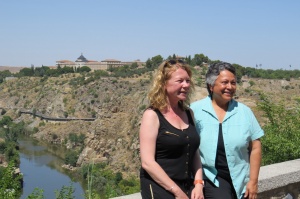Spain, a country of fiery love and passionate emotion.
If you don’t fall in love here, you might fall in love with love.
Feast of Sant Jordi
You can see Saint George, the dragon slayer, in many places around Barcelona. Like here on the facade of Modernist house Casa Amatller on Passeig de Gracia. Sant Jordi is the legend that inspired the giving of roses and he is the patron saint of Catalonia.
Did you know St. George didn’t marry the woman whom he saved by slaying the dragon? Nonetheless, he is regarded as the protector of lovers.
This is why the annual festival devoted to his name is Barcelona’s version of Valentine’s Day. Each year on April 23rd, which coincides with the date on which both Cervantes and Shakespeare died, the men give a single rose to all the women in their lives and the women gift their men a book. There are book readings, flower markets and signings throughout the city.



Il Travatore
In 15th century Zaragoza, the troubadour Manrico falls in love with Leonora, a woman adored by the Count di Luna. In an effort to keep them apart, Manrico is imprisoned and sentenced to death. Leonora takes a poison and confronts di Luna, offering herself in exchange for Manrico’s release. When di Luna discovers her deception, Manrico is executed at the beautiful Islamic Medieval palace, Aljaferia, and Leonora dies by poison. Their love story is the basis for Verdi’s famous opera, Il Travatore.


Duende
In Spain, the state of passion has a name: “duende.” Bullfighting and flamenco have the same roots, and both the torero and the flamenco dancer are said to receive the state of bliss. Thought to be mystical, inspirational, almost magical, it is a higher state of consciousness, transcendence. For the matador, it lies in the moment between life and death, the moment when he steps out of his own skin to meet the soul of the bull. For the flamenco dancer, it is a moment of artistic realization.
Perhaps duende comes from the deep, archaic suffering that is part of the Spanish soul: the early persecution of the Romani, the Muslims and the Jews in southern Spain that coincides with the emergence of flamenco. It is said that a woman shouldn’t dance until she is in her 30’s – she won’t have suffered enough, lived life enough, to convey the passion of flamenco.
Ahem
Why, we even saw the passion of Spain first-hand. For example, our lovely, trusted and trustworthy driver who shall remain nameless if not faceless. He spent two weeks on the road with us, always immaculately dressed, and he packed better than we did – he travelled with a garment bag. Somehow we learned (gossip travels fast on the Nap Machine) that he allegedly, perhaps, may have two families – a wife and children in one large Spanish city, and a wife and children just outside the same large Spanish city. And apparently, everyone is okay with that. A Spanish man of passion!
The affection in Spain was infectious and as we learned, sighed, ate and laughed our way across northern Spain in the Nap Machine, indelible memories and warm friendships were born.



Rosa and Chrissie were the heart, soul and brains of the operation, the most generous, most accommodating, most cheerful, fun and most fabulous instructors, Rosa Stewart and Christine Forster – MUCHAS GRACIAS!


Just like Don Q and Sancho, inevitably, we turn toward home.
We really do, just as our tour guide Rene Garcia instructed, go with happiness….
Jan
Back in Victoria, the 2015 Flamenco Festival:
επόμενος?

















Brillant – thanks Jan
Beautiful-I even read every single word… Hasta la próxima, Es Spania! X.
Gasp/sigh – until next time, Bella XOXOXO
Sent from my iPad
>
You have certainly captured the fun and passion of Spain.i love the photos.there are some great ones of you Jan.
XOXO
Sent from my iPad
> On Aug 25, 2015, at 10:48 PM, Carpe diem wrote
>
>